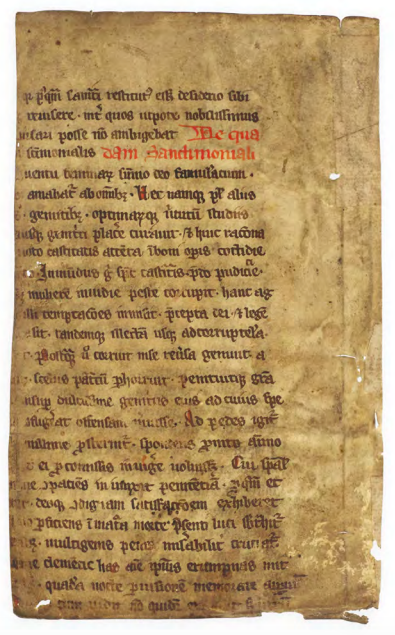Someone was kind enough recently to make me aware of a curious 14th-century German manuscript fragment on sale in the latest Bernard Quaritch catalogue which mentions Bury St Edmunds – or, more specifically, a miracle that took place ‘in the territory of St Edmund’. In addition to the well-known legend of Theophilus (famously the inspiration for the Faust legend), the manuscript contains two rarer miracle stories. One of these (also found in BL MS Add. 18346) concerns a crippled German nobleman who receives a vision telling him that he will be healed at a church dedicated to the Virgin Mary in territorio Sancti Eadmundi, at a place called Curdinges (in other manuscripts Curdiges or Turdinges). One of the people present at the healing is a newly baptised Jewish woman.
As I had not heard of this miracle before (which seems to exist only in German, and not in English tradition), my first thought was – where is Curdinges? The manuscript gives us two pieces of information about Curdinges: that it lies ‘in the territory of St Edmund’ (in other words, the Liberty of St Edmund in western Suffolk) and that the church of the place was dedicated to the Virgin Mary.
Given this information, the best candidate for Curdinges is probably Coney Weston, which appears as Cunegestuna in Domesday, derived from Old Norse Konungrestuna (‘the king’s town’). Since the Old English equivalent of konungres would be cuninges, the existence of a variant form of Cunegestuna as Cuningestuna is likely. If this was ever abbreviated to Cuninges, it gives us the initial and final elements of the blundered name Curdinges. Coney Weston’s parish church is indeed dedicated to the Virgin Mary, unlike the parish church of Cowlinge (another possible candidate for Curdinges, since it appears as Culinge in Domesday Book), which is dedicated to St Margaret of Antioch.
The only other piece of historical information the story gives us is that it occurred before 1290, when the Jews were expelled from England (or, in all likelihood, before 1190 when they were expelled from Bury St Edmunds). This is significant because it means the original transcriber of an oral narrative (if such a narrative existed) would have been dealing with an older version of a place name than what would have been familiar even in the 14th century. Clearly, as the name was transcribed and re-transcribed in a German manuscript tradition ignorant of East Anglian place names, errors will have crept in (Turdinges for Curdinges is an error to be expected, owing to the frequent interchangeability of the letters t and c in medieval scribal Latin).
So it is not possible to say with any certainty if Curdinges is Coney Weston; but if Curdinges is a real place at all, and was not irretrievably mangled by copyists, Coney Weston seems to me the most plausible candidate.

